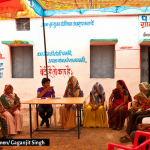
Modifying Government Structures for Fiscal Transparency in Karnataka: A Case Study
30 January 2022
Continuing from my previous blog on how governments might actually foster fiscal transparency, in the case of Karnataka, it began with the introduction of a system by which the budget documentation included an annexe. This separated the fund allocations made for the rural local governments.
As explained in my previous blog, the system survived, even if it was eroded by gradual centralisation whereby departments recaptured their devolved allocations and took those back to their own centralised budgets. However, one shortcoming remained, namely, that the allocations were made district-wise in bulk, and neither the intermediate, nor the village panchayats knew the further break up of funds to their levels.
The in-principle agreement of the state government that further transparency in financial allocations was required, translated into steady, but slow steps in that direction. In 2015, the state government appointed a committee headed by a seasoned politician to recommend amendments to the Karnataka Panchayat Raj Act. This was to strengthen rural local governments.
The recommendations of the Committee were far reaching, and touched upon many aspects of local government functioning and citizens’ participation.
One of the amendments suggested was that the local government had a ‘right to know’ the allocations made by various departments for spending within the formers’ respective jurisdictions, regardless of whether the activities to which these expenditures pertained were devolved or not. In other words, even if a Panchayat was not entrusted with the implementation of a particular departmental programme and it continued to be directly implemented by the department concerned, the Panchayat had a ‘right to know’ the financial allocations made for that programme.
As a member of the Committee, I was not too enthusiastic of this approach. I much preferred imposing a mandatory legal obligation on the departments concerned to disclose their information, making it a ‘right to know’, for the recipient of information, was, to my mind, a rather passive way of stating out the arrangement.
However, probably I was wrong and the politicians who piloted these proposed amendments were right. Slipping in a ‘right to know’ clause into the law, they contended, was a non-threatening foot in the shut door of fiscal information.
The amendment proposed was accepted and passed.
However, the wheels of government turn slowly. Laws have to backed by subordinate legislation to be operational. That happened in the course of time, through another stealthy reform.
Karnataka had since long, adopted a simple and elegant system of quick review of programmes. Introduced in the early 1980s as the MMR – which stood for ‘Monthly Multilevel Review’ – this was the brainchild of a brilliant officer, Mr. P.R. Nayak, who was the Development Commissioner then. The system was a checklist in which every programme was reviewed against monthly fiscal and numerical fiscal targets.
Departments were free to set their targets, both physical and financial and report it at every level of government where it was implemented. Back in the days when the only electronic device on the government table was a calculator, it enabled summing up of reports received at all levels to produce the report for the state.
Every level was to conduct its MMR meeting in the first week of the month, and by mid-month, the state MMR review was conducted. This approach was standardised, into the KDP meeting; KDP standing for ‘Karnataka Development Programme’.
The stealthy reform introduced was that each Gram Panchayat would now conduct its own KDP meeting. This was a significant step forward, because it gave the ‘right to know’ teeth, and an operational framework within which it could be exercised.
Each Gram Panchayat was now officially authorised to call all development officers who worked within its jurisdiction, regardless of whether they formally answered to the Panchayat or otherwise. They reported on their activities, physical and financial, on a month-wise basis.
The reform stuttered in implementation, but with steady monitoring, it began to take root. Panchayats began to conduct their KDP meetings and departmental staff in the Panchayat began to get habituated to report to them.
However, there was one lacuna remaining. The Gram Panchayat did not know a priori which schemes were implemented by each department within its jurisdiction. The financial and physical targets set out for these was also hardly known. Departments continued to harbour the mindset that breaking up their district-wise allocations to the level of each Gram Panchayat was impractical.
However, this was not for long.
In November last, the departments of Education, Women and Child Welfare, Health, Agriculture, and Sericulture did the seemingly impossible. They released Link Documents that broke up their expenditure allocations to the level of each Gram Panchayats.
This is a huge step forward.
At least four of these departments, namely, Education, Women and Child Welfare, Health and Agriculture are critical for rural development and prosperity.
Their activities are widespread. Every Panchayat has several schools and Anganwadis, and there is a Primary Health Centre and an Agriculture Farmers Service Centre for every two to three Panchayats. Knowledge of the financial allocations made by each department to each such field office, and the programmes that they implement, is critically important for Panchayats to plan. It is also critical to integrate their expenditures harmoniously with departmental expenditures to ensure efficient local development.
What else needs to be done? Is this enough? Look out for the next blog.
T.R. Raghunandan is an Advisor at Accountability Initiative.
Also Read: Accountability and Curbing Institutional Fragmentation in Urban Areas




